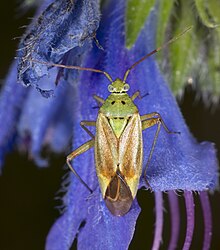Species of true bug
.mw-parser-output .hidden-begin{box-sizing:border-box;width:100%;padding:5px;border:none;font-size:95%}.mw-parser-output .hidden-title{font-weight:bold;line-height:1.6;text-align:left}.mw-parser-output .hidden-content{text-align:left}@media all and (max-width:500px){.mw-parser-output .hidden-begin{width:auto!important;clear:none!important;float:none!important))You can help expand this article with text translated from
the corresponding article in German. (July 2019) Click [show] for important translation instructions.
View a machine-translated version of the German article.
Machine translation, like
DeepL or
Google Translate, is a useful starting point for translations, but translators must revise errors as necessary and confirm that the translation is accurate, rather than simply copy-pasting machine-translated text into the English Wikipedia.
Consider
adding a topic to this template: there are already 9,119 articles in the
main category, and specifying|topic= will aid in categorization.
Do not translate text that appears unreliable or low-quality. If possible, verify the text with references provided in the foreign-language article.
You must provide
copyright attribution in the
edit summary accompanying your translation by providing an
interlanguage link to the source of your translation. A model attribution edit summary is Content in this edit is translated from the existing German Wikipedia article at [[:de:Closterotomus norwegicus]]; see its history for attribution.
You may also add the template ((Translated|de|Closterotomus norwegicus)) to the
talk page.
For more guidance, see
Wikipedia:Translation.
Closterotomus norvegicus (also known as the potato capsid) is a species of bugs belonging to the family Miridae, subfamily Mirinae.[2] It can be found feeding on nettle, clover,[3] and cannabis,[4] as well as Compositae, potatoes, carrots and chrysanthemums.[5] They prefer to feed on the flowers, buds and unripe fruit.[6] The species occurs in the Palearctic-British Isles and east across continental Europe to Siberia. It also occurs in the Nearctic as an adventive species. In 1997 it was moved from the genus Calocoris to its current name.[7]
Description
The species is green coloured as a nymph, but when they get to adulthood the colour changes to reddish brown. It does however, vary by territory; for example, specimens from northern Britain are brownish black. The prothorax has two spots, while its scutellum has dark marks.[3]
